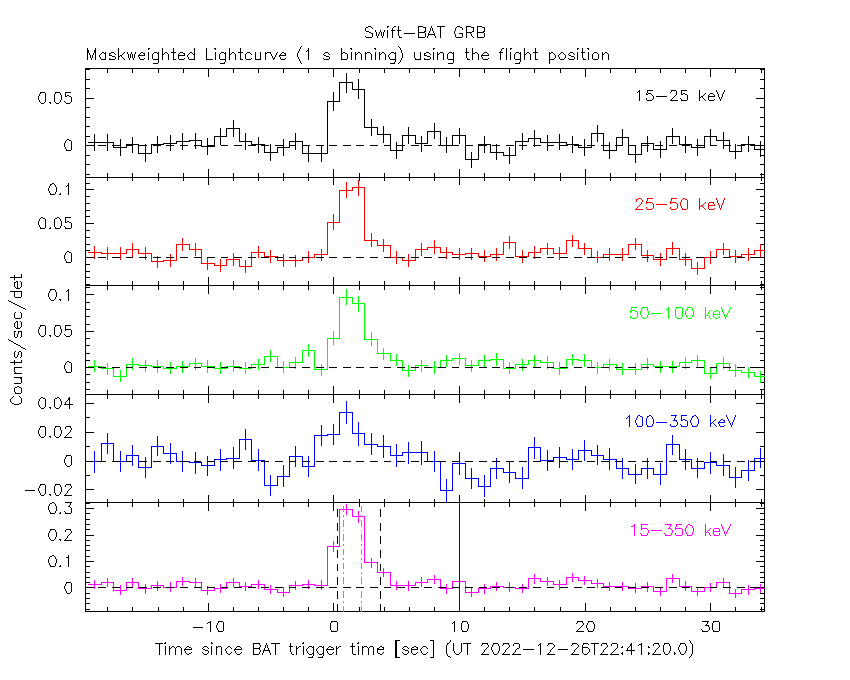
S.B. Cenko (GSFC), M. Capalbi (INAF-IASFPA) and N. Klingler (UMBC/NASA-GSFC/CRESST II) for the Swift team
At 22:41:20 UT, the Swift Burst Alert Telescope (BAT) triggered and located GRB 221226B (trigger=1145959) (Cenko et al. GCN Circ. 33108). Swift slewed immediately to the burst. At the time of the trigger, the initial BAT position was 87° from the Sun (7.2 hours East) and 52° from the 17%-illuminated Moon. Table 1 contains the best reported positions from Swift, and the latest XRT position can be viewed at http://www.swift.ac.uk/xrt_positions.
Xu et al. (GCN Circ. 33110) reported the position from VLT for the optical afterglow of this GRB. Klingler (GCN Circ. 33114) reported the detection with UVOT of an optical afterglow. Xu et al. (GCN Circ. 33110) determined a redshift of 2.694 from VLT. Table 2 is a summary of GCN Circulars about this GRB from observatories other than Swift.
Standard analysis products for this burst are available at https://gcn.gsfc.nasa.gov/swift_gnd_ana.html.
As reported by Laha et al. (GCN Circ. 33115),
the BAT ground-calculated position is
RA, Dec = 22.903, -41.515 deg which is
RA(J2000) = 0
The mask-weighted light curve (Figure 1) shows a pulse of approximately 4 seconds
total duration and some substructure.
The time-averaged spectrum from T+0.22 to T+4.28 s is best fit by a simple
power-law model.
The power law index of the time-averaged spectrum is
1.16 ± 0.13.
The fluence in the 15-150 keV band is 5.4 ± 0.5 x 1
The results of the batgrbproduct analysis are available at https://gcn.gsfc.nasa.gov/notices_s/1145959/BA/.
Analysis of the initial XRT data was reported by Capalbi et al. (GCN Circ. 33111). We have analysed 9.4 ks of XRT data for GRB 221226B, from 56 s to 68.1 ks after the BAT trigger. The data comprise 14 s in Windowed Timing (WT) mode (the first 9 s were taken while Swift was slewing) with the remainder in Photon Counting (PC) mode. The enhanced XRT position for this burst was given by Goad et al. (GCN Circ. 33109).
The light curve (Figure 2) can be modelled with a power-law decay with a decay index of α=1.57 (+0.13, -0.12).
A spectrum formed from the PC mode data can be fitted with an absorbed power-law with a photon spectral index of 1.6 (+0.4, -0.3). The best-fitting absorption column is 1.4 (+2.5, -1.4) x 1
A summary of the PC-mode spectrum is thus:
Galactic foreground: 1.7 x 1
Intrinsic column: 1.4 (+2.5, -1.4) x 1
Photon index: 1.6 (+0.4, -0.3)
The results of the XRT team automatic analysis are available at http://www.swift.ac.uk/xrt_products/01145959.
Analysis of the UVOT data was reported by Klingler (GCN Circ. 33114).
The Swift-UVOT began settled observations of the field of GRB 221226B 76 s after the BAT trigger.
A source consistent with the XRT position (Goad et al., GCN Circ. 33109) and consistent with the optical counterpart reported by VLT/X-shooter (Xu et al., GCN Circ. 33110) is detected in the initial UVOT exposures.
Table 3 gives preliminary
magnitudes using the UVOT photometric system
(Breeveld et al. 2011, AIP Conf. Proc., 1358, 373).
No correction has been made for the expected extinction in the Milky Way
corresponding to a reddening of

Figure 1. The BAT
mask-weighted light curve in the four individual and total
energy bands. The units are counts

Figure 2. The XRT light curve.
Any data from a crosshatched region are not included in the fit.
| RA (J2000) | Dec (J2000) | Error | Note | Reference |
|---|---|---|---|---|
| 0 |
-41°31'36.0" | 2.0" | XRT-final | UKSSDC |
| 0 |
-41°31'36.1" | 2.6" | XRT-enhanced | Goad et al. GCN Circ. 33109 |
| 0 |
-41°30'52.5" | 1.2' | BAT-refined | Laha et al. GCN Circ. 33115 |
| Band | Authors | GCN Circ. | Subject | Observatory | Notes |
|---|---|---|---|---|---|
| Optical | Xu et al. | 33110 | VLT/X-shooter redshift and host galaxy | VLT | redshift |
| Optical | Strausbaugh and Cucchiara | 33119 | LCOGT Optical Upper Limits | Las Cumbres Obs. Global Tele.Network | upper limits |
| Gamma-ray | Fermi | 33107 | Fermi GBM Final Real-time Localization | Fermi GBM | |
| Gamma-ray | Lesage and Meegan | 33112 | Fermi GBM Observation | Fermi GBM | Fluence=7.8±0.5x1 (brighter than 10% of long GRBs) |
| Filter | Exp(s) | Mag | ||
|---|---|---|---|---|
| white | 76 | 226 | 147 | 20.54 ± 0.22 |
| v | 4408 | 4608 | 197 | >19.3 |
| b | 3793 | 3993 | 197 | >20.0 |
| u | 288 | 5132 | 278 | >20.1 |
| w1 | 4818 | 5018 | 197 | >20.0 |
| m2 | 4613 | 4813 | 197 | >19.5 |
| w2 | 4204 | 4404 | 197 | >20.0 |
Table 3. UVOT observations reported by Klingler (GCN Circ. 33114). The start and stop times of the exposures are given in seconds since the BAT trigger. The preliminary detections and 3-σ upper limits are given. No correction has been made for extinction in the Milky Way.
December 29, 2022